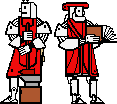Laboratory 6: Communicating Applications
Handout 1
Overview
There are two parts to this laboratory assignment. In this part, you will
build a simple graphical user interface and some additional infrastructure.
In the second half of this lab, you will augment that work. By the end of
this project, you will have built a very simple two-player video game.
The first week's lab focuses on the graphical user interface (GUI).
This assignment must be donewith a partner. Part of the
assignment is to be done jointly with your partner. Other parts of the
assignment are to be done individually. If you do not have a partner to work
with, please let the course staff know immediately.
This lab focuses on the following ideas:
- More graphical user interfaces/AWT.
- Shared state and concurrency issues
You should read through this entire assignment and complete the Lab
preparation section before you come to lab. Some portions of the Post Lab
write-up also require your thinking about them before and during the
laboratory portion of the assignment. It is important that you plan
your complete design before coming to lab.
Please include the names of anyone with whom you collaborate, in any way,
on this assignment. As always, you are welcome to discuss the assignment with
other students in the class as well. You should also indicate the nature of
any collaborations. [Failure to include this information is a violation of
the collaboration policy.]
This assignment is a two-week assignment, but the current handout covers
work to be done during the first week's lab. You will need to have this
labwork complete in order to be checked in to next week's lab. This handout
covers work to be done during the week of 1 November, 1999.
Contents
Introduction
The thing that you will be creating in this first half of the lab is
called a position panel. This is a Java component that keeps track of where
the mouse is and paints some sort of object (e.g., a circle) in the
appropriate place. It is important that you build a transaction-safe version
of this component, i.e., that it not be possible for the position panel to
paint the mark in a place where the mouse has never been.
Pre-Lab
Finger Exercises
In answering these questions, you may find it useful to refer to the Java
Applications Programmer Interface (API) documentation, especially
portions of the java.awt and java.awt.event packages.
1. Design a data
repository class that keeps track of an x and a y coordinate and has an
additional field of type int. (The additonal field might, for example, be
used to hold a symbolic constant.) Make sure that your class provides
transaction-safe access to its fields. It should be possible to change the
coordinates (both together), but not the additional type field. It should
also be possible to hand off (return, give another object) the x and y
coordinates safely. (Hint: think about the SafeCoordinate class that we built
in lecture.)
2. Design a class that extends
java.awt.Panel and keeps track of a location in screen coordinates.
(It can, for example, just have two ints as fields.) The
paint method of this class should draw a filled oval centered at the
specified point.
3. Design a class that extends
java.awt.Panel and keeps track of the mouse position. That is, it
should have a getMouse() method that can be called by other objects
and returns an object corresponding to the mouse's current location. You may,
of course, define auxilliary objects to help handle the relevant events.
Questions to think about:
- What events should you handle to provide this information?
- What objects will actually handle these events?
- How will they communicate with your extended panel?
- The mouse's location has two parts, a horizontal coordinate and a
vertical coordinate. How do you return both?
- How many threads can be running in your Panel extension at
once? Do they share state? How can you ensure that they are
transaction-safe?
4. Now design a class that combines all of
these behaviors. Your new class should extend java.awt.Panel and
keep track of (hint: field) the last location where the mouse was depressed,
i.e., the last place where a mousePressed occurred. The
paint method of this class should draw a filled oval centered at the
specified point.
- (Bonus) Modify your class so that it keeps track of the current mouse
position instead.
- (Extra Bonus) Add a getMouse()
method to your class. This method should be callable by other
objects and should return an object corresponding to the mouse's current
location.
Questions to think about:
- What events should you handle to provide this information?
- The mouse's location has two parts, a horizontal coordinate and a
vertical coordinate. How do you return both safely?
- How many threads can be running in this Panel extension at
once? Do they share state? How can you ensure that they are
transaction-safe?
B. Additional Lab
Preparation
In addition to working on the finger exercises, for this week you should
think through the assignment below and come to lab with a plan that includes
a solution to the problem set and a development plan for how you intend to
implement and test one stage at a time of your solution.
Setting Up a Panel
In this lab, you will be building a standalone application version of your
mouse-tracking position panel. In particular, you will need:
- An extended PositionPanel, i.e., a Panel that can
keep track of where the mouse is. (See the Finger Exercises.) This Panel will
also need to be able to paint several points. (See the Finger Exercises.) Note that it will
not simply paint location of the mouse; you should keep
these two functions somewhat separate. You will use this class later on
to paint the positions of both the Cat and the Mouse, so it should be
easy to change the locations of the points that are painted.
- A Frame that contains this PositionPanel. We have
given you one that you can use (cs101.awt.DefaultFrame.java),
or you can write your own. (See the section on Using our DefaultFrame, below.) At a
minimum, it should
- have a constructor that takes a Component as an
argument.
- have an init method that adds the
Component and handles sizing, showing.
- handle Event.WINDOW_DESTROY by calling
this.dispose() to free up any system resources and
System.exit(0) to complete execution.
- A top-level interface (Main) to set up your application.
Development
Plan
The final stage of pre-lab preparation is to write up a step-by-step
description of your incremental development plan. In particular, think about
the following:
- What is the minimum self-contained (i.e., testable) functionality that
you can implement?
- How will you test it?
- What can you add to make a slightly more complex and still fully
testable version?
- How would you test this?
Continue listing added features and tests until you scale up to your
complete design. This technique, incremental refinement, is an extremely
useful and practical way to write code. You may want to read through the
suggestions in the In the Lab section,
below.
Notes:
Using our DefaultFrame
To test your code, you may want to use our cs101.awt.DefaultFrame.java
class. DefaultFrame's constructor takes a Component as an argument and
displays that Component inside itself. (Your extended Panel should do just
fine.) DefaultFrame's init() method is responsible for
adding the Component, sizing, and showing it.
You will also need to write a main file that does the following:
- create a new instance of your panel.
- create a new instance of cs101.awt.DefaultFrame, passing your
panel as an argument to DefaultFrame's constructor.
- calls the DefaultFrame's init() method.
Note: You may want to include the following code to your extended panel
class:
public Dimension getMinimumSize() {
return new Dimension(200,200);
}
public Dimension getPreferredSize() {
return new Dimension(400,400);
}
This defines a size for the Panel; otherwise it will not report any size
and may not be displayed.
Laboratory
What to Bring to Lab
You should bring your answers to the finger
exercises as well as your design and implementation plan for this lab. In
addition, you should have thought out answers to all of the questions in the
laboratory preparation section and should be prepared to begin writing code
immediately upon entering lab. When you arrive at lab, you should have
answers to the questions in the lab preparation a copy of your code design and development plan (on-line or on paper) ready so
that we can check you into lab.
Getting Started
In lab, you should write and test the code that you designed.
As always, you should implement your code in simple, testable stages,
building on your code only as each stage works robustly. In this case, it
should be as simple as following your development
plan.
You will, of course, want to make use of your answers to the finger
exercises.
Before you leave
Before you leave lab, you will need to have your work checked off by a
course staff member.
At a minimum, you should expect to demonstrate an application that is
responsive to your mouse.
If your code does not behave as expected, you should be prepared to
explain why or to describe what you have done to try to figure out why.
If your code has more than this minimal functionality, you should be able
to describe and demonstrate what it does as well as how you were able to
achieve this behavior.
It is always more important that you write clean, modular,
well-documented and easy-to-understand code than that you go on to advanced
features.
Post-Lab, AKA What
To Turn In
There is nothing to turn in for this week's assignment, as the assignment
continues into next week. However, the work that you have done this week will
be a part of the turn-in for next week's assignment. Your completed
assignment should include:
- your pre-lab assignment, including the finger exercises.
- your development plan, along with a
description of how (if at all) it corresponds to what you actually did in
lab.
- your code or a pointer to it, and a description of its
functionality.
- documentation of your code. (This can be inside the code.)
- your observations concerning
- the name of the staff member(s) who
checked you into and out of lab, a brief description of the
check-out interaction, and answers to any specific issues s/he may have
asked you to address.
- a self-assessement on this week's lab. How well do you understand the
material after this lab?
This course is a part of Lynn Andrea Stein's
Rethinking
CS101 project at the MIT
AI Lab and the Department of Electrical Engineering and
Computer Science at the Massachusetts Institute of
Technology.


Questions or comments:
<cs101-webmaster@ai.mit.edu>
-
Last modified: Thu Jul 10 13:01:20 1999